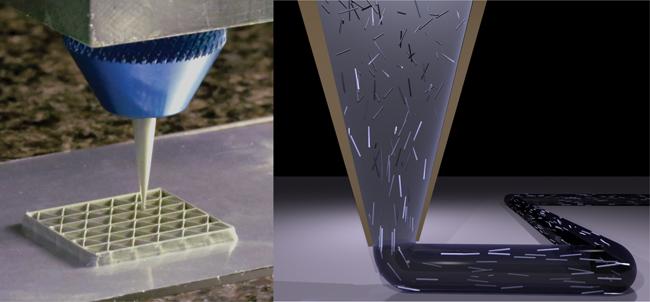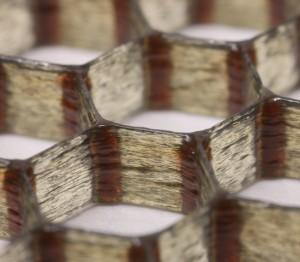3D printing processes have been undertaken using materials such as thermo plastics and UV-curable resins, but now materials scientists from Harvard’s School of Engineering and Applied Sciences have teamed up with the Wyss Institute for Biologically Inspired Engineering to create a printable epoxy-based thermosetting resin. These epoxies allow for the printing of materials to be used as structural components in lightweight architecture. These new 3D inks are composed of epoxy resins combined with nanoclay platelets for enhanced viscosity and a dimethyl methylphosphonate compound. To this mixture two fillers are added, silicon carbine and carbon fibers.
The directionality of those fillers in the ink controls the versatility and strength of the printed material. This particular mixture creates a composite that is adjustable in terms of strength and toughness and that is approximately 200% stronger than the best printed polymer composites currently available. The description of the research was published in the article “3D-Printing of Lightweight Cellular Composites” in an issue of Advanced Materials co-authored by Brett Compton and Jennifer Lewis.
 Lorna Gibson, professor of materials science and mechanical engineering at MIT explained the significance of the research:
Lorna Gibson, professor of materials science and mechanical engineering at MIT explained the significance of the research:
“This paper demonstrates, for the first time, 3D printing of honeycombs with fiber-reinforced cell walls. Of particular significance is the way that the fibers can be aligned, through control of the fiber aspect ration – the length relative to the diameter – and the nozzle diameter. This marks an important step forward in designing engineering materials that mimic wood.”
Why would it be important to be able to mimic wood in this way? After all, we already have wood, right?
A primary potential application for this ink is in the creation of structural honeycomb for use inside the blades of wind turbines. Currently, the insides of these blades are made using sandwiched construction materials, one of which is balsa wood. While balsa is a fast-growing tree that has been identified as a rapidly renewable resource, it does have grain variations that can make it difficult to make it meet the precise performance requirements set for such products. In addition, balsa wood is relatively expensive and as the length of the blades used in these wind turbines increases, even now there are some nearing 250 feet in length, the cost and need for precision grows as well. Using this ink and 3D extrusion printing techniques, the researchers have been able to create cellular composite materials that actually improve on balsa wood.
It’s not just wind turbines that may benefit from this new ink, as fuel efficiency requirements in the automotive industry have become stricter, a strong lightweight material such as this may be just what designers need to help their cars these requirements. Compton sees an exciting future made possible with this epoxy:
“As we gain additional levels of control in filler alignment and learn how to better integrate that orientation into component design, we can further optimize component design and improve materials efficiency. Eventually, we will be able to use 3D printing technology to change the degree of fiber filler alignment and local composition on the fly.”
 Future research plans for the team include exploring thermosetting resins that have precisely aligned and blended fillers as potential materials for both their structural and conductive capabilities. What other uses could such a material have? Discuss this story in the 3D printed epoxy composite forum thread on 3DPB.com.
Future research plans for the team include exploring thermosetting resins that have precisely aligned and blended fillers as potential materials for both their structural and conductive capabilities. What other uses could such a material have? Discuss this story in the 3D printed epoxy composite forum thread on 3DPB.com.
Subscribe to Our Email Newsletter
Stay up-to-date on all the latest news from the 3D printing industry and receive information and offers from third party vendors.
You May Also Like
Meltio Expands Global Reach with New Partnerships in the Americas and Europe
Spanish 3D printing manufacturer Meltio has expanded its sales network across the globe. With the addition of three new partners in the United States, Brazil, Argentina, and Italy, Meltio aims...
3D Printing Webinar and Event Roundup: April 7, 2024
Webinars and events in the 3D printing industry are picking back up this week! Sea-Air-Space is coming to Maryland, and SAE International is sponsoring a 3D Systems webinar about 3D...
On the Ground in Linares, Spain for the Meltio M600 Launch
As detailed in a previous post, metal 3D printer manufacturer Meltio launched its latest wire-laser metal deposition (LMD) machine, the Meltio M600, at its headquarters in Linares, Spain. There, I was...
Blue Laser-powered M600 3D Printer Launched by Meltio
Founded in 2019 as a joint venture between Additec and Sicnova, metal 3D printer OEM Meltio develops and manufactures high-performance and easy-to-use metal 3D printing solutions that use its patented wire-laser metal...
































